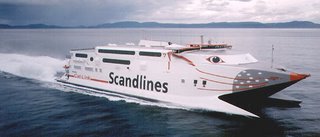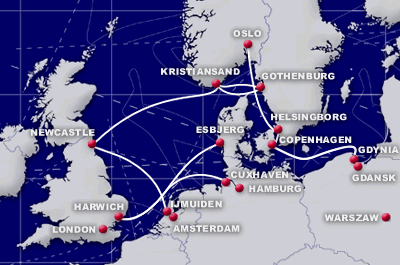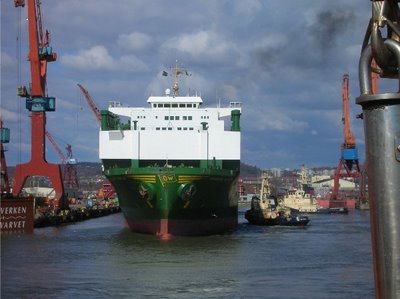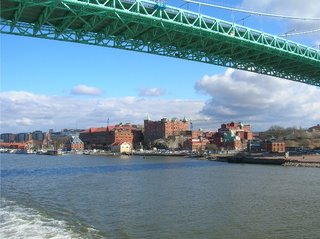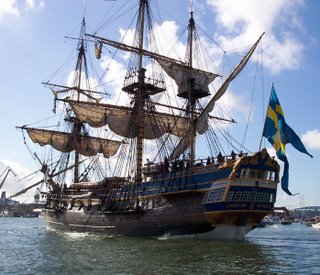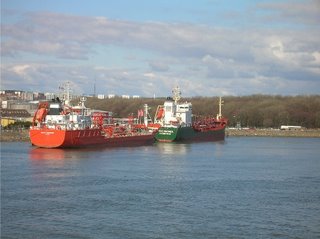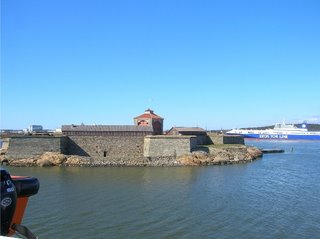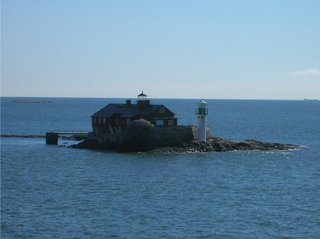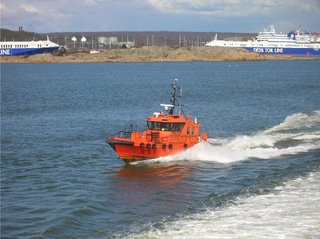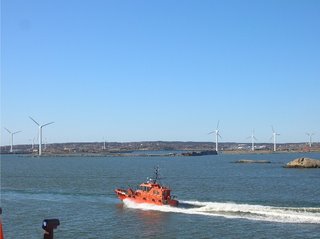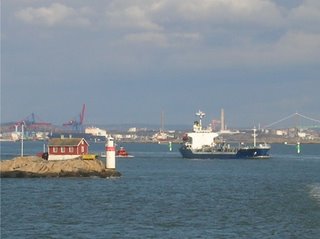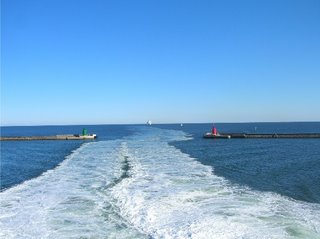The Hamlet of Hornslet...
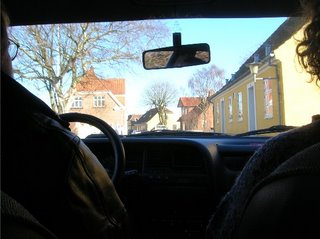
So we had arrived on the sandy soil of Denmark. Almost as soon as we were off the ferry, we darted into the quaint little streets of Frederikshavn to search for some fish to cook for dinner.
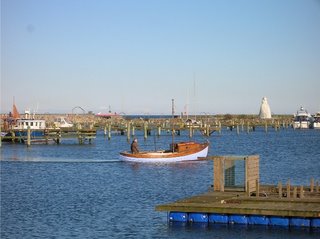 We drove straight to the harbor--much to my delight--and the fish docks where a few local merchants had set up a retail shop. The fish was so fresh--coming stright in off of little fish boats like this that puttered in and out of the harbor--that the flounders laid out on the bed of crushed ice were still gasping and lethargically waving their pectoral fins in dying gestures of distress.
We drove straight to the harbor--much to my delight--and the fish docks where a few local merchants had set up a retail shop. The fish was so fresh--coming stright in off of little fish boats like this that puttered in and out of the harbor--that the flounders laid out on the bed of crushed ice were still gasping and lethargically waving their pectoral fins in dying gestures of distress.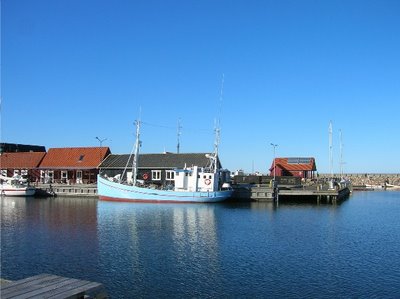 At one end of the protected basin the larger fishboats, painted the traditional light blue, lay alongside the wharf unloading.
At one end of the protected basin the larger fishboats, painted the traditional light blue, lay alongside the wharf unloading.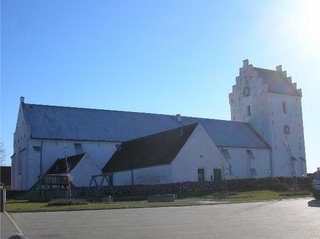 Just a short distance from the water stood one of the aged churches built on the eve of the Renaissance. As I was about to learn, these venerated old structures with their stepped facades are one of the architectural icons of Denmark.
Just a short distance from the water stood one of the aged churches built on the eve of the Renaissance. As I was about to learn, these venerated old structures with their stepped facades are one of the architectural icons of Denmark.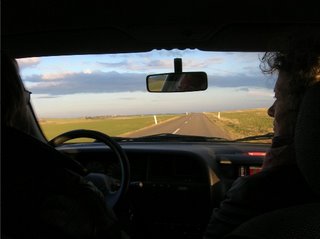 Back on the road again we drove south toward the city of Århus, steaking across miles and miles of beautifully green fields, contrasting with the greys and browns of Sweden, a nation still held in the grips of the dying Nordic winter.
Back on the road again we drove south toward the city of Århus, steaking across miles and miles of beautifully green fields, contrasting with the greys and browns of Sweden, a nation still held in the grips of the dying Nordic winter. Everywhere, the horizon was lined with the iconic windgenerator, turning lazily in the ever-present breeze that blows across Denmark either from the North Sea or the Baltic.
Everywhere, the horizon was lined with the iconic windgenerator, turning lazily in the ever-present breeze that blows across Denmark either from the North Sea or the Baltic.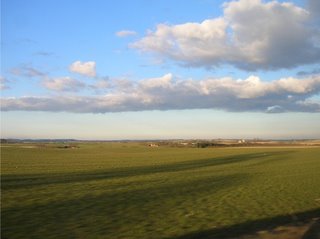 As the sun sank lower and the shadows lengthened, the pleasant green fields took on a warmer hue and I nodded off in the back seat...again.
As the sun sank lower and the shadows lengthened, the pleasant green fields took on a warmer hue and I nodded off in the back seat...again. I awoke as dusk fell and we streamed past the first of many Danish castles. Most of them are not fortresses, but rather private resorts for the wealthy landowners comprising expansive gardens, enormous barns and stables, and occasionally a lilly-covered moat just for show.
I awoke as dusk fell and we streamed past the first of many Danish castles. Most of them are not fortresses, but rather private resorts for the wealthy landowners comprising expansive gardens, enormous barns and stables, and occasionally a lilly-covered moat just for show.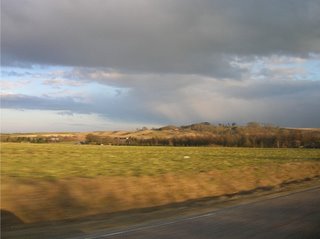 In time we wentered the rolling hills of the Århus region, created over 10,000 years ago when the receding glaciers deposited mounds of sand and gravel upon the landscape. In every little gully and washout left by the melting ice, we passed another classic little Danish hamlet snugly tucked down out of the wind.
In time we wentered the rolling hills of the Århus region, created over 10,000 years ago when the receding glaciers deposited mounds of sand and gravel upon the landscape. In every little gully and washout left by the melting ice, we passed another classic little Danish hamlet snugly tucked down out of the wind.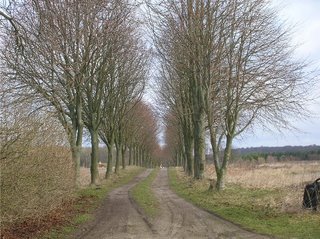
Then alas we arrived in the little hamlet of Hornslet and turned onto the long, tree-lined driveway to the house where Ole and Annette live. Oh! the delight of discovering that this beautiful landscape--such a wonderful respite from the city--was to be my home for the next 10 days!
 At the end of the driveway we came up to their cute little farm house nested between the trees on the edge of the forest. It was as charming a place as I have ever seen....
At the end of the driveway we came up to their cute little farm house nested between the trees on the edge of the forest. It was as charming a place as I have ever seen....
Ole and Annette took me around the property, showing me how their home was once three farm buildings sitting together and Annette (an architect by profession) had slowly adapted them and united them with new roofs, hallways, or greenhouses.
 In the middle of the three conjoined houses there was a little courtyard full of dense shrubs, a small pond, and a great tree draped with birdfeeders.
In the middle of the three conjoined houses there was a little courtyard full of dense shrubs, a small pond, and a great tree draped with birdfeeders.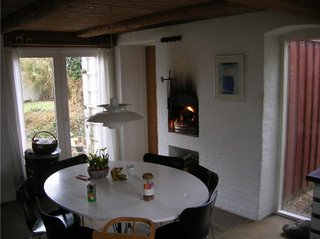
The kitchen table looked directly out onto this courtyard, guaranteeing mealtime entertainment from the lovely but often quarrelsome birds.
 Annette's kitchen, with its low ceiling and rough-hewn beams, the oven-shaped windows, and the airy skylights over the counter was an extremely pleasant place to sit and relax, listening to the rain drumming on the roof.
Annette's kitchen, with its low ceiling and rough-hewn beams, the oven-shaped windows, and the airy skylights over the counter was an extremely pleasant place to sit and relax, listening to the rain drumming on the roof.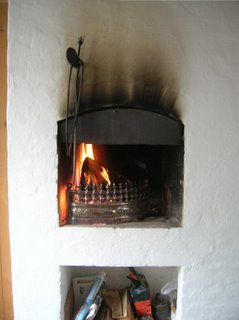 The crowning touch to the pleasant atmosphere in there was the little chest-high fireplace set into the wall that crackled and glowed all day and night, filling the kitchen with wonderful smells and a most pervasive warmth.
The crowning touch to the pleasant atmosphere in there was the little chest-high fireplace set into the wall that crackled and glowed all day and night, filling the kitchen with wonderful smells and a most pervasive warmth. Around the corner in the next building was the livingroom, another great place built of traditional materials but enhanced by sliding glass partitions and towering windows and skylights as well as a veritable canpoy of leafy indoor trees.
Around the corner in the next building was the livingroom, another great place built of traditional materials but enhanced by sliding glass partitions and towering windows and skylights as well as a veritable canpoy of leafy indoor trees. THese trees hung down from the rafters all over, giving the room a most refreshing feel--and a daily shower of dead leaves to pick up.
THese trees hung down from the rafters all over, giving the room a most refreshing feel--and a daily shower of dead leaves to pick up.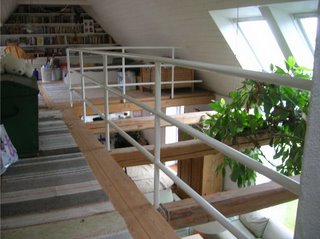 Above the living room there was a great balcony and reading lounge...
Above the living room there was a great balcony and reading lounge...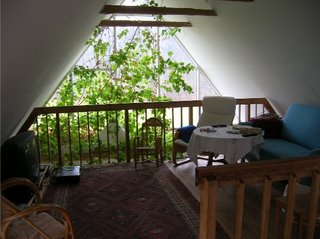 And an airy little TV room that could have been a tree-house.
And an airy little TV room that could have been a tree-house. Just beyond the 'U' of connected houses lay the barn where bales of hay, a collection of rope-making equipment, and a few interesting piles of broken machinery and lawnmowers sat waiting to be useful again.
Just beyond the 'U' of connected houses lay the barn where bales of hay, a collection of rope-making equipment, and a few interesting piles of broken machinery and lawnmowers sat waiting to be useful again. At one end stood the heating room for the farm house. All the water and radiator heat was provided by this big oven into which we threw a bale of hay every two or three hours. I had never seen a hay-heated home before, but it worked remarkably well and gave the air outside a most wonderous scent.
At one end stood the heating room for the farm house. All the water and radiator heat was provided by this big oven into which we threw a bale of hay every two or three hours. I had never seen a hay-heated home before, but it worked remarkably well and gave the air outside a most wonderous scent.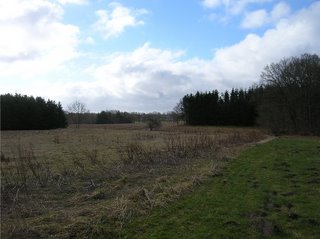 Ah, it was so wonderful just standing in the yard and gazing out across the fields, smelling the hay smoke, and listening to the birds excitedly chirping about this rumor of spring.
Ah, it was so wonderful just standing in the yard and gazing out across the fields, smelling the hay smoke, and listening to the birds excitedly chirping about this rumor of spring.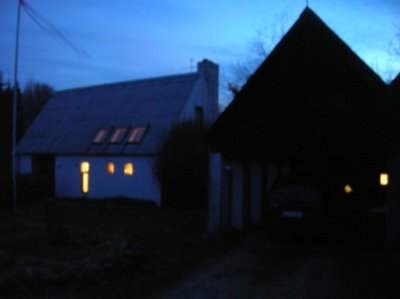 And when night fell and the deer came out to graze, it was a most splendid feeling to just watch the millions of stars coming out over the little farm house with is warmly glowing windows.
And when night fell and the deer came out to graze, it was a most splendid feeling to just watch the millions of stars coming out over the little farm house with is warmly glowing windows.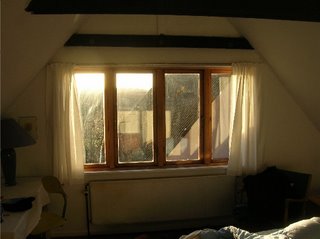 Up in the guest room, I awoke early to the morning sun pouring in. It so very much reminded me of staying in the attic room of Jeremy Glover's farm in Wisconsin. It was simply wonderful...
Up in the guest room, I awoke early to the morning sun pouring in. It so very much reminded me of staying in the attic room of Jeremy Glover's farm in Wisconsin. It was simply wonderful... As I came down the little ladder to the ground floor I heard the unmistakable cackle of a pheasant--and it was close! As soon as I looked out the window, there he was; a nice plump rooster sitting on an old well head oustide the barn.
As I came down the little ladder to the ground floor I heard the unmistakable cackle of a pheasant--and it was close! As soon as I looked out the window, there he was; a nice plump rooster sitting on an old well head oustide the barn.
He stood and watched, I stood and watched. He flapped his wings and cackled, I snapped a photo.

After a classic Danish breakfast of brown bread with boiled egg, cucumber, tomato, or sliced onions, Ole and Annette and I set ou in the car to explore the town and the neighboring countryside. The little roads around the town and tracing all over the hills and through the woods were most delightful and no sooner did we get ou tthere than I was asking if Ole had a bicycle I could borrow. "Of course!" he said. After all, Ole was a bicycling addict and had once spent three months living off his bicycle, riding from place to place until he had toured all of Denmark.

As we drove around we passed several of the neighboring villages, also tucked down in th egullies out of sight where the land couldn't be used for farming and where it was protected from the ever-present wind.
 We passed over the tracks which reminded me so sharply of my wanderings in Wisconsin and Illinois. I wonder where these ones lead....
We passed over the tracks which reminded me so sharply of my wanderings in Wisconsin and Illinois. I wonder where these ones lead....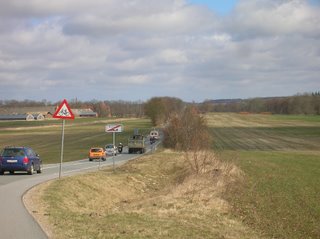 And we ran into some of those classic farming community sights like fields of rolling furrows and...
And we ran into some of those classic farming community sights like fields of rolling furrows and...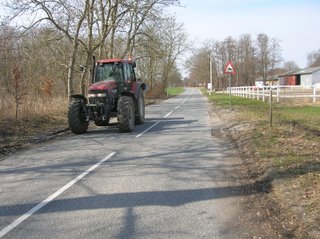 ...huge tractors asserting their equal rights to the roads.
...huge tractors asserting their equal rights to the roads.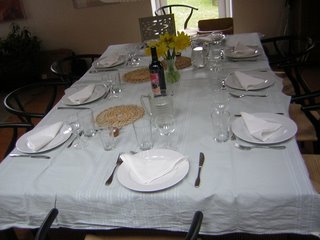 When we returned to the farmhouse in the early afternoon, the first wave of children and grandchildren had already arrived and it was time to preapre for the first of several big family gatherings. Not really knowing how to properly set a Danish table, I pitched in and tried to help out. At least the toddlers made it easy for me; I knew where to put the high-chairs, the miniature spoons, and the pile of napkins.
When we returned to the farmhouse in the early afternoon, the first wave of children and grandchildren had already arrived and it was time to preapre for the first of several big family gatherings. Not really knowing how to properly set a Danish table, I pitched in and tried to help out. At least the toddlers made it easy for me; I knew where to put the high-chairs, the miniature spoons, and the pile of napkins.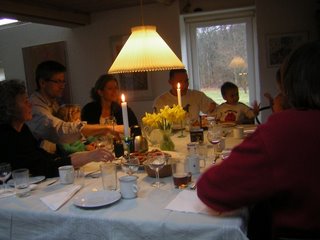 We were joined for that first big dinner by Ole's children, Mads and Ida and Ida's little boy, Noah. Then Annette's daughter Katrin came with her husband Holger and their two little children, Matilda and Alexander. It was quite a crowd in no time at all.
We were joined for that first big dinner by Ole's children, Mads and Ida and Ida's little boy, Noah. Then Annette's daughter Katrin came with her husband Holger and their two little children, Matilda and Alexander. It was quite a crowd in no time at all. We settled in for a very fine dinner with the usual family banter (or so I assumed from body language as I could not understand a word of Danish) and naturally, the rather amusing stream of culinary demands and critiques accompanied by the dropping of little spoons and the occasional spitting up--all from a particular end of the table.
We settled in for a very fine dinner with the usual family banter (or so I assumed from body language as I could not understand a word of Danish) and naturally, the rather amusing stream of culinary demands and critiques accompanied by the dropping of little spoons and the occasional spitting up--all from a particular end of the table.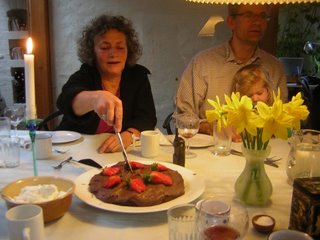 However, despite these occasional protests against the vegetable group or ardent demands for "farfar" (grandpa), the children were remarkably well-behaved, a trend I have seen across Scandinavia.
However, despite these occasional protests against the vegetable group or ardent demands for "farfar" (grandpa), the children were remarkably well-behaved, a trend I have seen across Scandinavia. Then Annette brought out the fudge cake and although the little ones were destined to become a total mess, let me tell you, it was absolutely worth it.
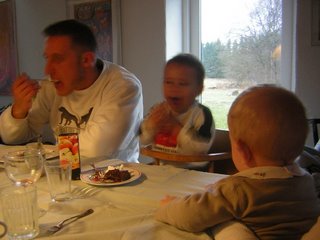 Here, Mads and his nephew Noah 'The Blur' express their appreciation for the cake in their own unique ways. Meanwhile, Alexander--the littlest of all--looks on with perplexed amusement.
Here, Mads and his nephew Noah 'The Blur' express their appreciation for the cake in their own unique ways. Meanwhile, Alexander--the littlest of all--looks on with perplexed amusement.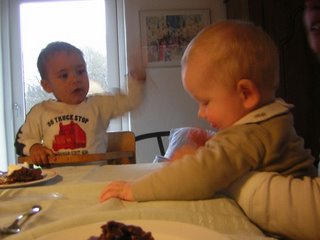 Feeling pity for his younger dining colleague who cannot understand the excitement, Noah attempts to explain to Alexander the many decorative virutes of fudge. Unfortunately the tablecloth seems to offer more entertainment than the otehrwise enlightening lecture.
Feeling pity for his younger dining colleague who cannot understand the excitement, Noah attempts to explain to Alexander the many decorative virutes of fudge. Unfortunately the tablecloth seems to offer more entertainment than the otehrwise enlightening lecture.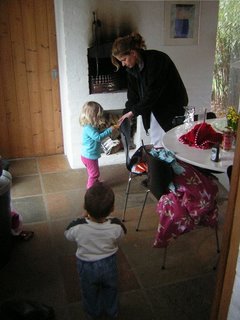 Fully fuelled with sugar, Noah and Matilda take to exploring the house at speeds most short-legged dachsunds can only dream of. Thus it was a near tragedy when Mom gave the departure warning and the little coats were brought out. Tears...
Fully fuelled with sugar, Noah and Matilda take to exploring the house at speeds most short-legged dachsunds can only dream of. Thus it was a near tragedy when Mom gave the departure warning and the little coats were brought out. Tears... Meanwhile, however, Alexander was rather enjoying himself. He had been welcomed into the adult conversation still going on around the wreckage of the table and he had also noticed a bowl with a fair bit of whipcream in it. This night was not over by any means!
Meanwhile, however, Alexander was rather enjoying himself. He had been welcomed into the adult conversation still going on around the wreckage of the table and he had also noticed a bowl with a fair bit of whipcream in it. This night was not over by any means!
